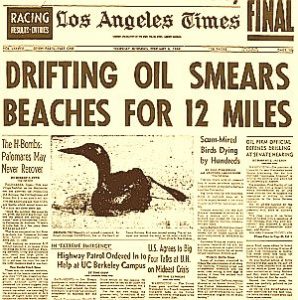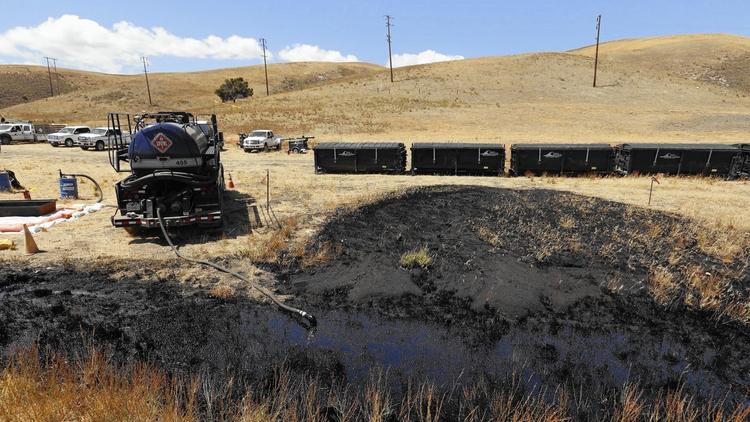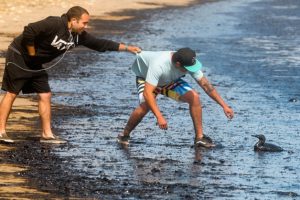Refugio Oil Spill History: Timeline Part 1
The one-year anniversary of the Refugio Oil Spill has brought with it a raft of renewed interest in this oil spill and the consequences as we now see them. We’ve done a good deal of media over the last couple of weeks. Add to that plenty of breaking stories from all quarters (often speaking to pending or future litigation) and the public now has a much better sense of what actually happened in the lead-up to the spill as well as the still-growing legacy of this injury.
What follows is my take on what we know as of May 19, 2016, 365 days post release of oil. This is the first in a series of posts about what happened and what we know of the impacts from the largest oil spill on this stretch of our California coast since the infamous 1969 Santa Barbara Oil Spill.
Factoids:
- An estimated 148,000 gallons of oil released, with at least 60,000 gallons accumulating on the beach/nearshore ocean at Refugio State Beach.
- Pipeline operators were unaware oil was spilling from their rupture pipeline. Failing to detect the leak, the controller even restarted the line after the spill occurred.
- Actual response/clean-up did not begin until Day 2.
Timeline:
Relevant Pre-Spill History
note: This is a very short list, but it represents what I have found to be often under-appreciated facts, essentially to understand the Refugio Spill.

Summerland oil piers near Santa Barbara, circa 1901-1903. Image: Title Insurance and Trust/C.C. Pierce Photography Collection, USC Libraries.
- 1890’s: oil discovered in Summerland California and western Ventura County.
- 1896: Summerland’s offshore oil field becomes the first marine petroleum deposit to ever be drilled. Extractors use terrestrial drilling technology operated from extensive piers projecting out into the sea.

- 1969: January 28, Union Oil Platform Alpha off of Summerland, CA suffers a blowout beginning the Santa Barbara Oil Spill. At the time it is the largest marine oil spill in U.S. History. The spill is mythic and became a central part of the origin story of the modern environmental movement. To say the the ramifications from this event were huge is an understatement. This spill helps usher in the modern era (the so-called “Golden Age”) of Environmental Legislation, helping build tremendous support for new state and federal laws such as the Endangered Species Act, Clean Water Act, National Environmental Policy Act, California Environmental Quality Act, and California Coastal Act.
- 1989: Exxon Valdez Spill covers Prince William Sound with north slope Alaskan crude after the drunken captain leaves navigation to a junior officer as he sits in his cabin below decks. This spill motivated the phase out of single hulled oil tankers, fostered the Oil Pollution Act of 1990, and spurred the best suite of oil spill impact studies to date. This also leads to the creation of our current suite of Natural Resources Damage Assessment protocols, activated post spill to documenting spill impacts.
- 1991: Responding to environmentalist and popular pressure, the Plains All American Pipeline is constructed, reducing the need for moving oil via tanker in the Santa Barbara Channel.
- 2004: Responding to post 9/11 fears of eminent terrorist threat, the newly created Department of Homeland Security massively overhauls the National Incident Command System, creating the framework with which we now respond to oil spills.

- 2010: Deepwater Horizon’s failed cementing of an exploratory wellhead into the Macondo lease off the Louisiana coast leads to 87 days of continuous oil flowing into the northern Gulf of Mexico and creating the largest marine oil spill in U.S. history and the deepest such blowout ever. Most of this impact was at the bottom of the ocean and the midwater region of the water column, although significant surface and littoral oiling occurs. While a temporary deepwater drilling moratorium was enacted, it was soon repealed under political pressure from the oil and gas industry. No significant legislation nor any substantial policy resulted (save for breaking up of the Minerals Management Service into daughter agencies) from this unprecedented spill, the first time a spill of such magnitude lead to effectively no change in oil spill response.
- 2012: Plains All American detects significant corrosion issues with Line 901.
Refugio Spill Day 1: May 19, 2015
note: My own recollections and notes are augmented below by testimony by Plains All American Pipeline, Pipeline and Hazardous Materials Safety Administration, Santa Barbara County Fire Department, Coast Guard, and the U.S. and California EPAs.

The oil pipeline rupture at Refugio State Beach may have spilled as much as 105,000 gallons of crude, authorities said. (Al Seib / Los Angeles Times)
- prior 10:45: Plains All American pipeline segment 901 ruptures due to extensive external corrosion of the metal pipe and begins leaking oil for some unknown period of time through paper-thin pipe walls. The rupture happens landward of the 101 Freeway, just inland from Refugio State Beach about 32 km (20 mi) west of downtown Santa Barbara.
- 10:45: The 61 cm (24”) pipeline segment 901 that transports crude oil roughly 18 km (11 mi) between Las Flores Canyon and Gaviota has ruptured. Plains All American’s Midland, TX pipeline command center shuts down oil flow in the pipeline by depowering pumps at the their inland Sisquoc Station for inspection and maintenance. The company is oblivious to any oil spillage and does not realize oil is flowing unchecked into the environment at this point.
- 10:55: Pipeline pumps are restarted, pouring pressurized oil out of the pipeline fracture. Pumps are shut down again approximately 20 minutes later. Within three minutes of restarting, pressure plunged to 199 psi, triggering a low-pressure alarm that quickly resets when pressure climbed just above 200 psi. The alarm was set to be tripped at such a low pressure that it never sounded again as oil flowed out the pipe at just above 200 psi trigger level. An additional leak detection system that also would have sounded alarms had been disabled by an operator who was dealing with another problem/maintenance.
- 11:15: Pipeline pumps are turned off again, still with no realization by operators any oil has spilled.
- 11:30: A Plains operator remotely shuts down the entire pipeline because of pressure anomalies causing concern in the pipeline command center in Midland, TX.
- 11:42: An unidentified member of the public at Refugio State Beach calls 911 reporting a pungent smell. Santa Barbara County Fire Department and California State Parks respond to the 911 call as (crazy as it may sound) a preparedness drill with emergency workers and Plains employees is about to start. These first responders (not the company) reach out to the National Spill Response Center (an informational clearinghouse for releases of hazardous substances) to report a potential oil spill based on the heavy crude oil smell in the air.
- 12:20: Firefighters finally discover oil flowing across the beach and into the ocean.

This classic image of Derek Fisher holding onto the shirt of Steven Botello on May 19, 2015 as he reaches out to an oil soaked bird on Refugio State Beach. Image: Lara Cooper/Noozhawk.
- 12:30 Plains dispatch in Midland, TX dispatches a worker to do a visual inspection of the pipeline, still unaware an oil spill is in progress.
- 12:39 The Coast Guard is notified.
- 12:47 The Coast Guard calls the National Spill Response Center to confirm and oil spill has happened.
- 13:30: A Plains All American employee finally confirms an oil spill has happened. About the same time, Santa Barbara firefighters manage to partially staunch the flow of oil onto the beach by damming a storm drain with dirt and rocks.
- 13:56: The National Spill Response Center notifies the Federal Environmental Protection Agency a spill has occurred.
- 14:56: Plains All American notifies National Spill Response Center a spill has occurred, estimating at least 21,000 gallons has leaked (current estimates put the volume about seven times this amount).
- 15:00: California State University Channel Islands is notified of an oil spill. Our ESRM Program immediately begins mobilizing field crews to sample sandy beaches, an annual task routinely scheduled to begin June 1 of each year. This was no small feat as the semester had concluded the week before.
- 16:00: Refugio State Beach is closed. It will remain closed until July 17.
- sometime before sunset: Clean Seas oil spill response vessel arrives on scene, but determines it can do little before sunset and will not be able to mobilize its required fleet of voluntary fishing vessels to help with surface booming to contain floating oil until the morning.
- 16:30: traffic slowdowns have become extensive along the 101 Freeway adjacent to Refugio Beach as onlookers attempt to view what is happening and California Highway Patrol attempts to block drivers from pulling over along the roadside for better looks. At least two private citizens operate drones near the site (an action still totally legal and permitted at this point). My neighbors who happened to be driving by Refugio at the time and were unaware of the spill reported a very pungent smell that was not alleviated with closed windows nor recirculated air. They also reported headaches.
- evening of May 19: media reports a spill has happened and that Refugio State Beach is closed, but with almost no facts they report mostly speculation and eyewitness accounts from beachgoers.
Refugio Spill Day 2: May 20, 2015

ESRM Sandy Beach Team members Chase Tillman and Paul Spaur exchange observations with a bird monitor at El Capitan State Beach on the morning of May 20, 2015.
- 5:00: the Incident Command formally activates, airspace over the spill is closed, ocean vessel traffic is restricted
- 6:30: CSUCI’s ESRM Rapid Beach Assessment Team is onsite at El Capitan State Beach, conducting rapid beach health assessments. No oil has yet arrived to El Capitan sands, Clean Seas in booming the ocean surface just offshore of El Capitan Beach.
- 9:30: State Park Lifeguards begin asking campers at El Capitan to voluntarily remain on the bluffs and not come down to beach.
- 11:00: State Park Lifeguards begin to close El Capitan State Beach, informing campers that they must evacuate state property immediately. We conclude our sampling of El Capitan State Beach just as Lifeguards formally close the beach to public access.
- 12:00: Our ESRM team is refused access to Refugio State Beach and out petition to map spill extent with our drones go unanswered, even after being asked to help map the site by one federal agency (but that is a story for another time).
- 13:00: ESRM samples Gaviota State Beach. We begin to be inundated with media requests for reports of impacts and first hand observer accounts of the spill.
- prior to 17:00: the first oil begins arriving on El Capitan State Beach.
Stay tuned for the next post with the continuation of the Refugio Timeline…


